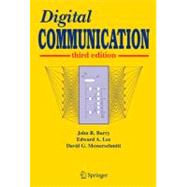
What is included with this book?
| Preface | |
| Changes from the Second Edition | |
| Notes to an instructor | |
| Introduction | |
| Applications of Digital Communication | |
| Digital Networks | |
| Digital vs Analog Communications | |
| Plan of the Book | |
| Further Reading | |
| Deterministic Signal Processing | |
| Signals | |
| LTI Systems and Fourier Transforms | |
| The Nyquist Sampling Theorem | |
| Downconversion and Complex Envelopes | |
| Z Transforms and Rational Transfer Functions | |
| Signals as Vectors | |
| Properties of the Fourier Transform | |
| Spectral Factorization | |
| Stochastic Signal Processing | |
| Random Variables | |
| Random Processes | |
| Markov Chains | |
| The Poisson Process and Queueing | |
| Further Reading | |
| Power Spectrum of A Cyclostationary Process | |
| Power Spectrum of A Markov Chain | |
| Derivation of a Poisson Process | |
| Moment Generating Function of Shot Noise | |
| Limits of Communication | |
| Just Enough Information About Entropy | |
| Capacity of Discrete-Time Channels | |
| Further Reading | |
| Asymptotic Equipartition Theorem | |
| Pulse-Amplitude Modulation | |
| Baseband PAM | |
| Passband PAM | |
| The One-Shot Minimum-Distance Receiver | |
| Minimum Distance Sequence Detection | |
| Performance Analysis in AWGN | |
| Further Reading | |
| Advanced Modulation | |
| M-ary Modulation | |
| Probability of Error | |
| Orthogonal Modulation | |
| Orthogonal Pulse-Amplitude Modulation (OPAM) | |
| Modulation with Memory | |
| Bandwidth and Signal Dimensionality | |
| Capacity and Modulation | |
| Further Reading | |
| The Generalized Nyquist Criterion | |
| Probabilistic Detection | |
| Detection of a Single Real-Valued Symbol | |
| Detection of a Signal Vector | |
| Known Signals in Gaussian Noise | |
| ML Sequence Detection with the Viterbi Algorithm | |
| A Posteriori Probability Detection with BCJR | |
| Symbol-Error Probability for MLSD | |
| Incoherent Detection | |
| Shot Noise Signal with Known Intensity | |
| Further Reading | |
| Karhunen-Loeve Expansion | |
| Bit-Error Probability for Sequence Detectors | |
| BCJR Forward/Backward Recursions | |
| Equalization | |
| Optimal Zero-Forcing Equalization | |
| Generalized Equalization Methods | |
| Fractionally Spaced Equalizer | |
| Transversal Filter Equalizers | |
| ISI and Channel Capacity | |
| Further Reading | |
| DFE Error Propagation | |
| Adaptive Equalization | |
| Constrained-Complexity Equalizers | |
| Adaptive Linear Equalizer | |
| Adaptive DFE | |
| Fractionally Spaced Equalizer | |
| Passband Equalization | |
| Further Reading | |
| SG Algorithm Error Vector Norm | |
| MIMO Communications | |
| Basics of MIMO Systems | |
| The Gaussian MIMO Channel | |
| Memoryless MIMO Channels | |
| MIMO Detection with Channel Memory | |
| Further Reading | |
| Proof of Separability Result (10.45) | |
| Fading and Diversity | |
| Types of Diversity | |
| Receiver Diversity | |
| Performance Analysis for Rayleigh Fading | |
| The Diversity-Interference Trade-Off | |
| Transmit Diversity | |
| Layered Space-Time Modems | |
| Proof of Conservation Theorem | |
| Bound on Pairwise Error Probability | |
| Error Control | |
| The Capacity Penalty of Binary Coding | |
| Binary Linear Block Codes | |
| Convolutional Codes | |
| Low-Density Parity-Check Codes | |
| Turbo Codes | |
| Historical Notes and Further Reading | |
| Linear Codes | |
| Maximal-Length Feedback Shift Registers | |
| Path Enumerators | |
| Derivation of the Tanh Rule | |
| Signal-Space Coding | |
| Multidimensional Signal Constellations | |
| Trellis Codes | |
| Coset Codes | |
| Signal-Space Coding and ISI | |
| Further Reading | |
| Phase-Locked Loops | |
| Ideal Continuous-Time PLL | |
| Discrete-Time PLLs | |
| Phase Detectors | |
| Variations on a Theme: VCOs | |
| Further Reading | |
| Carrier Recovery | |
| Decision-Directed Carrier Recovery | |
| Power of N Carrier Recovery | |
| Further Reading | |
| Timing Recovery | |
| Timing Recovery Performance | |
| Spectral-Line Methods | |
| MMSE Timing Recovery and Approximations | |
| Baud-Rate Timing Recovery | |
| Accumulation of Timing Jitter | |
| Further Reading | |
| The Poisson Sum Formula | |
| Discrete-Time Derivative | |
| Multiple Access Alternatives | |
| Medium Topology for Multiple Access | |
| Multiple Access by Time Division | |
| Multiple Access by Frequency Division | |
| Multiple Access by Code Division | |
| The Cellular Concept | |
| Exercise Solutions | |
| Index | |
| Table of Contents provided by Publisher. All Rights Reserved. |
The New copy of this book will include any supplemental materials advertised. Please check the title of the book to determine if it should include any access cards, study guides, lab manuals, CDs, etc.
The Used, Rental and eBook copies of this book are not guaranteed to include any supplemental materials. Typically, only the book itself is included. This is true even if the title states it includes any access cards, study guides, lab manuals, CDs, etc.